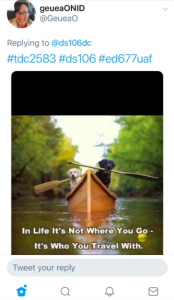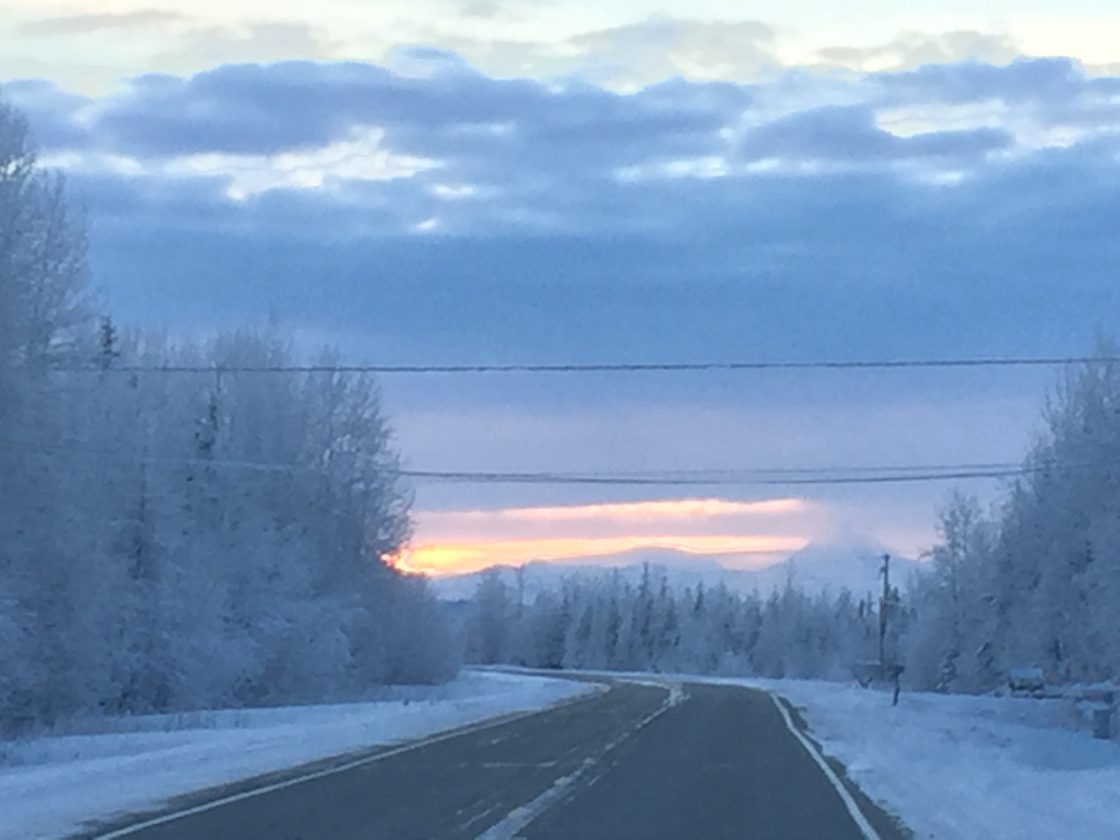Day One – Whitehorse to Ft Nelson (What do we mean by story?)
On this storytelling road-trip, my peers and I are exploring diverse methods of delivering narratives and having conversations about what constitutes a story. On our first leg we considered, “What do we mean by story?” To press the question, we examined “Entrances and Exits,” by Reif Larsen (2016). This journey through portals on Street View maps and narrative text was fun and new, like a treasure hunt across the globe. For me personally, I think I am drawn to stories that are written cleverly; I am ever in search of authors I consider to be wordsmiths. This phrase by Larsen (2016) caught my attention, “We contract our names when we grow close and then expand them again when we flee. Life is a series of contractions and expansions, as natural as breathing itself.”
One of my classmates, Rebecca Williams, made a couple of interesting comments during this stage of our trip. In a story about a lesson she learned from one of her professors about communication, she observed that “Communication is an active process between the person sending the communication and the person receiving it.” She also wrote that, “the essence of wisdom and the essence of a story rely on the receiver’s or audience’s reception.” Both of the comments relate to the questions I am asking myself – How do I become a storyteller who can read my audience in such a way as to fluidly change my delivery so that my listeners are transported? How can I integrate more forms of storytelling into my classroom beyond my standard oral delivery and satisfy personalized learning goals at the same time?
On a lighter note, here is a hysterical video that challenges traditional storytelling ideas. As a matter of fact, the creator of the video Adam Patch, has quite a few innovative yet untraditional stories on his website.
Day Two – Ft Nelson to Medicine Hat (Whose stories?)
It was during this leg of the journey when we really started deeply discussing connections. We read a couple of chapters from The Truth About Stories by Thomas King (2011) that really made me think about the storytelling I do in my classroom and about how I try to connect my students to the past. It occurred to me that I have been guilty of passing along the narratives of my ethnicity without considering different truths. King (2011) reveals how the stories of the past truly affected his and his people’s present, “For us to be seen as “real,” for people to “imagine” us as Indians, we must be authentic” (King, p. 55). In our class chat stream, Deanna Waters said that Thomas, “Didn’t usurp [my] narrative, he was building a connection between our individual narratives.” That is when I started to wonder if I am using stories to their full potential in the classroom.
Day Three – Medicine Hat to Story, WY (Can you prove it?)
This final leg of our road trip was meant to “push[es] us a bit out of ourselves, our experiences, and all the glorious, qualitative bits of storytelling” (Newman, 2019). At least one of the readings we were assigned had that effect for me. My body – A Wunderkammer by Shelley Jackson (1997). Can I prove that this was a story? Not so much for me… Our class chatstream seemed mostly centered around the question of truth and the potential harm in stories. Classmate Rebecca said, “How much of what we believe is based on the creation of a compelling story more than actual facts?” This lead to conversations about religion, media, and politics. All stories in one way, shape, or form…
Here is where I began to formulate the questions I stated in italics above. I was first inspired by Paul Zak’s (2013) idea of readers being “transported.” He describes this as happening when, “a story has sustained our attention long enough, we may begin to emotionally resonate with story’s characters” (para. 16). I was equally impressed with how Ursula LeGuin (2004) describes communication (and thus storytelling) as “everything ‘transmitted’ — everything said — is shaped as it is spoken by the actual or anticipated response” (p. 188). I hereby accept the responsibility of describing characters from history in such a way that my students will emotionally resonate with them and I realize that how I formulate the stories is shaped by how I hope the students will react to them. Now all I have to perfect is the medium and the delivery.
Finally, in my attempt to find tips for improving the way I hook or make connections with my students, I found an author by the name of Bethany Johnson. She writes all kinds of things, but for her J-O-B she works with big brands to help with public exposure through social media and advertising. In her “6 Content Engagement Techniques That Are Way Better Than “Hooking’ Readers,” Bethany Johnson (2017) listed the following storytelling tips:
- Take a hard stand.
- Or Don’t
- locate the story behind the story
- tell a good story
- read minds
- leave something out
These are excellent tips for engaging and connecting with listeners. What is left to be explored is the theme of this course: digital storytelling. I think my nescience of technologically geared foci took my mind to that which I am well acquainted – oral storytelling. All that is described above related to the latter. That is where my interest has always been, thanks to my dad. He was the greatest storyteller in my life. As I write, I can picture him sitting in a living room full of children who are listening attentively to his stories. However, as my knowledge base of digital storytelling builds, I find myself wondering how much I don’t know. My story just gained a twist…
References
Johnson, B. (2017, May 25). 6 Content Engagement Techniques to Prove Readers Can’t Be “Hooked”. Retrieved February 13, 2019, from https://www.skyword.com/contentstandard/storytelling/6-content-engagement-techniques-way-better-hooking-readers/
King, T. (2011). The Truth About Stories: A Native Narrative. New York: House of Anansi Press.
Larsen, R. (2016). Entrances and Exits. Retrieved January 25, 2019, from https://visual-editions.com/entrances-and-exits-by-reif-larsen
Guin, U. L. (2004). The wave in the mind: Talks and essays on the writer, the reader, and the imagination. Boston: Shambhala.
Patch, A. (n.d.). Two Chips: A Short Animation. Retrieved February 13, 2019, from https://www.adampatch.com/
Zak, P. (2013, December 7). How Stories Change the Brain. Retrieved February 10, 2019, from https://greatergood.berkeley.edu/article/item/how_stories_change_brain

I love reading about how you use storytelling in your teaching — and how some of what we’ve read has you reflecting on and rethinking the technique. Be sure to check out Chris’s post for a different angle on similar questions!
You borrow the structure of the course to tell a story of questioning — we learn how you came to the question you chose to write about, how you refined it and, at the end, research you did to help you respond to the question. I was surprised to see that you let a quotation have the final word in your post! Are Betsy’s words the best answer you came to for your question? The fullest answer?
UAF eCampus maintains a digital storytelling resource website, and this page has some resources that might help you uncover more techniques for telling responsive and transporting stories: sites.google.com/alaska.edu/digitalstorytelling/storytelling
You are right! As an English teacher I should have known better! I just crashed into my ending! Lol. I really just didn’t think about it. I guess I felt like I answered the questions and the quote seemed like a dramatic ending.